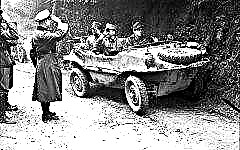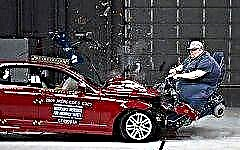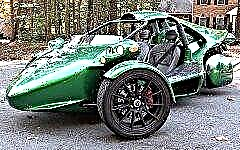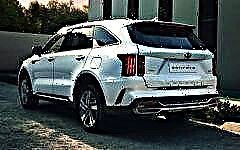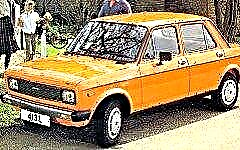

The content of the article:
- Popular Yugoslav cars
- Jugo 45
- Zastava 750 - "Fisa"
- Citroen 2CV - "Spaсek"
- NSU Prinz
- Zastava 101 - "Stojadin"
- Austin
- Renault 4
- Ikarbus
- FAP
Among the countries of Eastern Europe, the auto industry was most weakly developed in Yugoslavia, where most of the regions had an agricultural rather than an industrial orientation. Nevertheless, the produced models deserve a story and their page in the world automobile annals.
Popular Yugoslav cars
The countdown of the automotive industry in Yugoslavia should be conducted since 1939, when the first factories started operating in two cities simultaneously - Serbian Kragujevac and Macedonian Skopje.
Yugoslavia was not a member of the Council for Mutual Economic Assistance (CMEA), and therefore had the right to produce any model to its taste. Just like every country has its own car symbol, so here it was the Jugo 45, which opens the list of the most interesting models.
Jugo 45

In the photo: Jugo 45 sample 1980-1986
It is striking that this subcompact car, which was very popular not only in all the Balkans, but also successfully exported to America, was included in the anti-rating of the worst cars in the world in the entire history of the automotive industry.
Produced from 1980 to 2008 under the brand name "Zastava", it was copied from the Italian Fiats - models 127 and 128, from which the chassis was also borrowed. The very first copy was solemnly presented to the then president of the republic, after which it went into mass production.
For the Winter Olympic Games in Yugoslavia in 1984, the release of a new model was timed, which received a 1.1-liter 55-horsepower engine, a new dashboard and cloth door trim. And by 1987, thanks to overseas success, a sports version was being developed, outdated carburettors were replaced with Bosch electronic ignition, and stronger powertrains and 5-speed transmissions appeared.
In total, during its existence, almost 800 thousand copies were released, which were sold all over the world: to Germany and England, the USA and Italy, to the Soviet republics. Moreover, more than 140 thousand models were purchased in America alone.
And even after the end of production, the car did not sink into oblivion - the production license along with the equipment was bought by a Turkish manufacturer, where the car continued to be published under the Tofas brand.
Zastava 750 - "Fica"

In the photo: people's favorite feature
When designing this car, Fiat was also taken as a basis, only its 600th model, which has a classic layout with an engine in front and a leading rear axle. While the chief engineer of Fiat realized the impracticality of a design that narrowed the body, increased the height of the car, weight and cost, and developed a unique model with a single engine and transmission unit located at the driving rear wheels.
It was this car that began to be imitated all over the world, and it was he who became the prototype for "Feature".
The release of the Yugoslav version began in 1955 - it was produced in an amount of more than 900 thousand copies, until it went under license to the same Turkish Tofas.
The aluminum body was longer than the Italian model, the car had disc brakes on the front wheels, saved fuel and accelerated to 100 km / h.
The practical model was often used by government agencies for official needs, which, with common popular love, made it iconic. There are still fan-clubs "Fichi", whose members claim that the car has become not only a symbol of the era, but also of the country itself and the way of life of its citizens.
Citroen 2CV - "Spacek"

In the photo: "The Ugly Duckling" Citroen 2CV
A car for transporting at least two people and a sack of potatoes, requiring no more than 3 liters per hundred kilometers and moving at least 65 km / h - this was planned by the creator of this model.
In addition, designed to adapt farmers to the new "iron" age, it had to have such a smooth ride that during the trip it would not kill the eggs that were being transported for sale.
The name of this small car literally means "two horses", that is, the conditional power of the power unit, which is subject to taxation by law. Despite the fact that the model was instantly nicknamed "the ugly duckling", it embodied a number of solutions that were quite progressive for its time, for example, front-wheel drive and adjustable spring suspension.
At the same time, the car was extremely simple and not prestigious, so that absolutely any person, whether a worker or a farmer, could afford it. In addition, Citroen 2CV was maintainable, had a decent carrying capacity and maneuverability, and thanks to the removable fabric roof, it was possible to transport a large number of various goods.
With all its curious appearance, the machine was produced for several decades in various countries, so its total production from 1948 to 1990 exceeded 8 million copies.
NSU Prinz

This car was born on German soil in 1957, but already in 1963 production moved to Yugoslavia.
The first models were a kind of coupe, which had a rear row of seats, but with such limited space that it was not easy for adults to accommodate there. The trunk, fuel tank and spare wheel were in the front, and a rather noisy 2-cylinder 20-horsepower engine was installed at the rear of the NSU Prinz.
The layout of the power unit, transmission and main gear made it easy and quick to service the model, and the engine, even with its roar, was economical and very reliable.
The car existed from 1962 to 1973, and only the Sarajevo plant produced 15 thousand copies.
Zastava 101 - "Stojadin"

This model can actually be called a cover version of the Fiat-128, which won the Car of the Year award in 1972. However, unlike the prototype, the Yugoslav engineers made the car more elegant and modern.
It was a practical hatchback with a large luggage compartment, obtained by folding the rear row seats, which Fiat did not have.... Thanks to this appearance and parameters, the model interested European consumers, who opted for the Balkan rather than the French version.
Therefore, the car was actively exported to England, France, Germany, Poland, Czechoslovakia, Hungary, Syria, Bulgaria, even to Ethiopia and Greece.
It is not excluded that, out of envy of a competitor, Zastava filed a lawsuit against Peugeot for using index 101 in the name, since such combinations of numbers were considered a "chip" of the French manufacturer. But the Yugoslav plant with dignity defended its rights to the model, which quickly became a national treasure of the country.
Stojka, Stojadin, Kets (translated into Russian - "time"), as soon as drivers did not tenderly name this car, which for almost 40 years of its existence changed modifications, interior and exterior, but still remained elegant and reliable.
The model, released in the amount of 1.2 million copies, was discontinued from the Serbian plant Kragujevac in 2008.
Austin

In the photo: One of the most popular models of the British company Austin - the ancestor of the famous MINI
Under a British license at the Slovenian IMV plant, several modifications of the Austin car were produced at once, including the first 5-door hatchback with 5 speeds Austin Maxi 1500. Under the spacious body, engineers placed a completely new front-wheel drive chassis for 1965, associated with unprecedented luxury - a 5-speed transmission.
The model had a very spacious interior, in which fully reclining front seats made it possible to comfortably spend the night in the back seat in the event of a long trip.
With comfort, good reliability, competitive cost, the car quickly found its consumer, which allowed it to exist from 1970 to 1981.
Renault 4

In the photo: Blue jeans car
The same IMV plant produced one of the most popular cars of the post-war Old World.
Conceived as accessible to everyone, primarily for the working class, simple and high-quality, "like jeans", suitable for the city and country roads, economical but moderately elegant, this car began to be developed back in 1949, but saw light only in 1961.
Although critics ridiculed the resulting model for an overly rustic look and a bulky tailgate, it must be admitted that the car turned out to be really budget, high quality and harmonious.
The combination of a progressive technical part with a truly ascetic simplicity provided a tremendous success for the car, which in fact became the ancestor of all modern hatchbacks.
The frame structure, front-wheel drive unusual for the 60s, replaceable, independent body that does not contain any units and that very revolutionary tailgate made the model unique and desirable all over the world.
During the production period from 1961 to 1994, over 8 million copies were produced, which were sold not only in Europe, but were also actively ordered by African countries.
Ikarbus

In the photo: Ikarbus is one of the rare Balkan automakers that has survived to this day.
Yugoslavia was also famous for its buses, which, however, were also produced under the license of a world-famous plant - MAN. One of these was the Ikarbus plant, which was forced to add the letter "B" to its name because of the conflict with the world famous Hungarian Ikarus.
The automobile production that grew out of an aircraft factory under the supervision of two Serbian aircraft manufacturers can be called one of the few enterprises in the socialist world that has survived to our times.
In the 50s, a lot of experienced personnel was redistributed to the Yugoslav aircraft factory SOKO, and so that the plant would not stand idle, it was decided to re-equip it for the production of buses.
Now the enterprise has a wide range of products - city and intercity buses, short-base, low-floor buses with a capacity of 46 to 100 passengers.
FAP

Photo: FAP 2026
The most common freight transport in Yugoslavia has been producing a motor-building plant in Serbian Priboi since 1953. Under the license of the Swiss company "Saurer", 8-ton bonnet trucks equipped with a 6-cylinder 8.3-liter 145-horsepower diesel engine with a 5-speed gearbox were assembled.
Gradually, the company acquired other licenses, including the Leyland and Perkins firms, which allowed it to expand to the full-scale FAP-FAMOS holding, which later included the TAZ bus factories in Zagreb and Skopje. After the conclusion of an agreement with Daimler-Benz, the plant undertook to assemble 10 thousand cargo engines each year, as well as diesel engines.
The political situation, the disintegration of the republic and the subsequent hostilities gradually brought the plant's activities to zero, which was completely closed in the 90s.
Conclusion
In Yugoslavia, there was an unusual market model, when the state did not influence the economy with administrative instruments, preferring decentralized governance and freedom of decision-making on the ground.
That is why there were so many automobile assembly plants in every federal republic, and they produced "enemy" capitalist cars, which thus received a Balkan residence permit.

